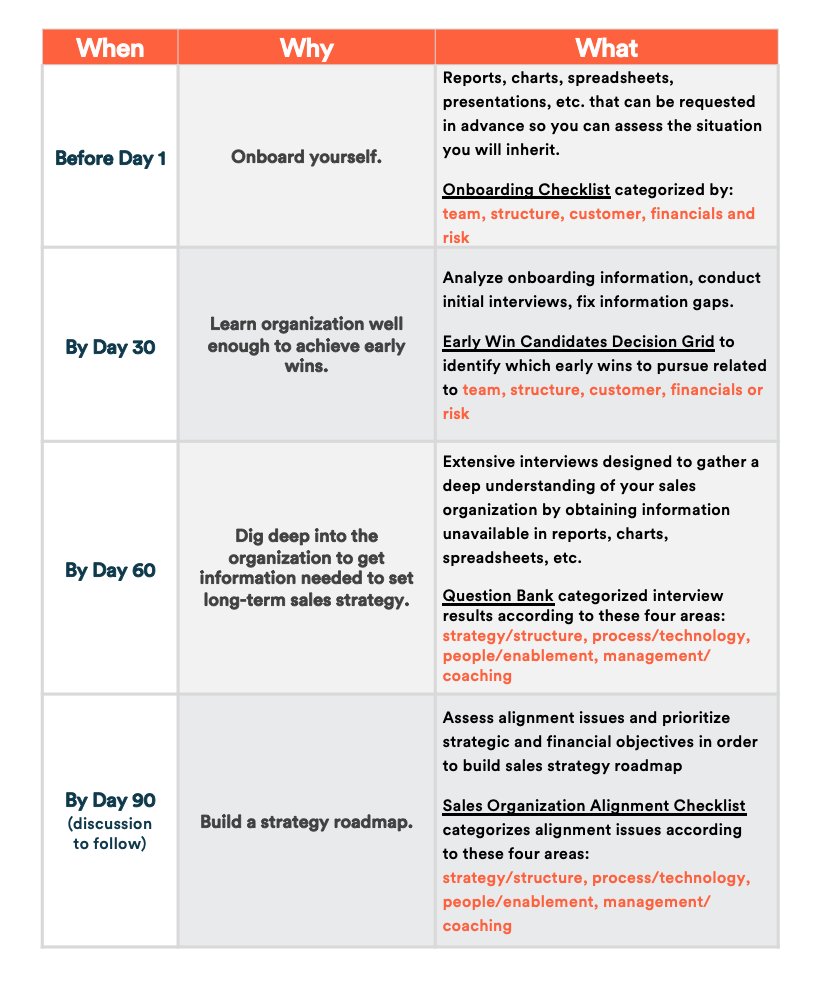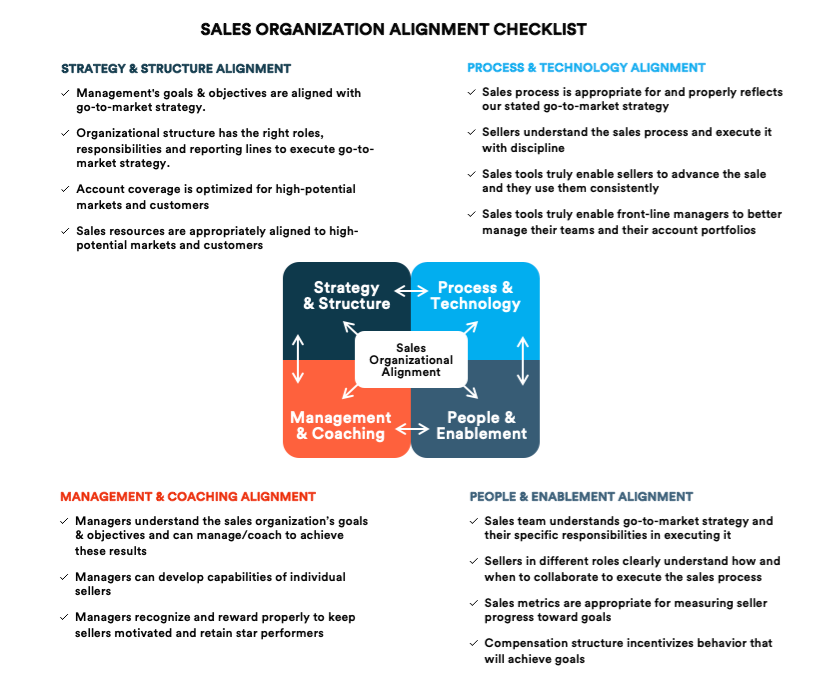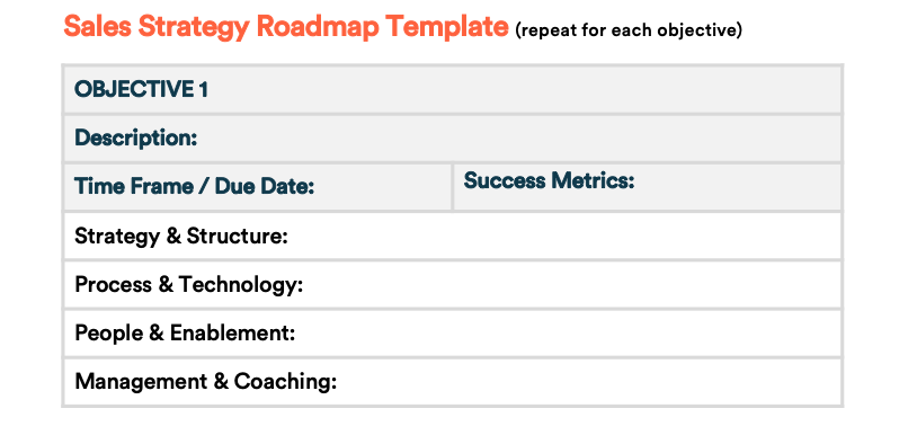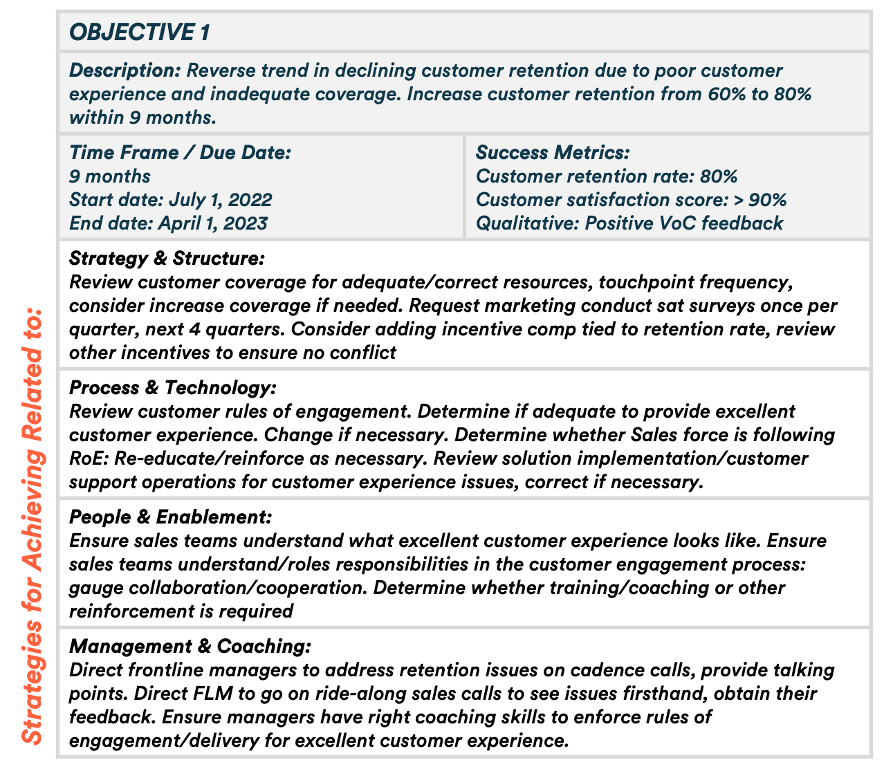This is the conclusion of our multi-part exploration of how sales leaders approach their first 90 days in a new role.
We’ll show you how to organize the considerable information you’ve gathered, find alignment issues, and build a roadmap.
For those of you just catching up:
-
Article 1 tackled onboarding yourself with the new company and offered strategies for cutting through the fog of transition
-
Article 2 offered concrete steps for balancing the need to learn with the need to take quick action to achieve early wins. This is the Secure & Get Right Method (days 1-30)
-
Article 3 showed you how to dig deep into the sales organization to systematically surface the knowledge you’ll need to determine longer-term strategy. We also gave brief introduction to a typical “alignment issue” (days 30-60)
By Day 60: What You Should Have Accomplished
So far, in your new role, you should have:
- Taken necessary steps to secure your team, customers, and define structure and financials
- Achieved early wins to establish credibility with your management, peers, and reports
- Conducted an extensive discovery effort to understand the organization, including: people, processes, technologies, financials, management’s objectives or initiatives, culture, risks
- Crystallized the business situation you’ve inherited (start-up, turnaround, mandate to grow) well enough to understand where opportunities lie and what needs repair
- Established alliances and cultivating relationships with influencers who will be instrumental to future success
Transition Trap BOLO: Trap #6
During month three, lookout specifically for transition trap #6:
- Over-estimating your team’s capacity to absorb and sustain changes that you intend to make
The other transition traps are important, but you’re likely to encounter this one as you begin implementing your strategy.
Your Final 30 Days Objectives
During month three (days 60-90), we recommend taking these four actions:
- Organize all learnings to date and review them. What do you see?
- Identify major alignment issues
- Determine and prioritize longer-term objectives
- Build a sales strategy roadmap to achieve objectives and heal alignment issues
Organize Your Learnings to Surface Potential Roadmap Objectives
The theme that threads its way through our series is learning. We’ve asked you to gather enormous amounts of information. Let’s discuss how to organize it for the big picture and creation of a sound sales strategy free of assumptions.
But first, let’s summarize our information gathering effort so far:

As you can see, there are commonalities for categorizing learnings. You should combine them and organize your first 90 days data into the following areas:
- Strategy and Structure
- Process and Tools
- People and Enablement
- Management and Coaching
- Financials and Risk
Let’s get tactical on how to accomplish this.
First, choose a technology medium and stick to it. Go low tech and use a spreadsheet with five tabs labelled as we’ve suggested above.
Second, delegate the sorting, summarizing, and analyzing to a strategy assistant.
Don’t have one? Here are five suggestions for acquiring one:
- Ask to have one assigned
- Beg, borrow, or steal this expertise from another exec
- Hire a consultant with a sales background
- Outsource to a capable gig economy worker from a reputable firm
- Find a member of your own sales team with the right capabilities
Third, use the tools to draw conclusions. This will naturally lead to a list of potential roadmap objectives. Keep a running objective list and prioritize them as you analyze your learnings. That makes building your roadmap easier.
We previously cautioned that you’d likely experience an overwhelming temptation to NOT be as rigorous in learning as we recommend. Skimp on this activity and won’t recover from the inevitable mistakes.
We urge you delegate where practical, but also do not back away from the heavy lifting.
Moving onto Alignment: What’s the Big Deal?
Alignment is important. Any misalignment between moving parts in your sales organization creates drag, which can result in annoyance to organizational harm.
You control the engines of revenue for the company. Any alignment issue that affects the sales organization is also affecting the company’s revenue.
Candice Freeman discovered as much when her new company’s management handed her a) a mandate to obtain recognized revenue faster and b) a compensation structure that rewarded sellers for contract signatures. This was a misalignment between sales objectives and behavior that produced an undesirable result.
When Alignment Bows to Competitive or Financial Pressure
Sometimes misalignment occurs when a well-intentioned go-to-market strategy falls victim to the pressures of sales quota. Here, the misalignment is not overtly stated. Instead, sellers observe misalignment behavior in the sales leader and agree to perpetuate it.
Say your go-to-market strategy is grounded in delivering a superior customer experience. But the current reality includes revenue shortfalls, cost over-runs, and a sales VP who’s harping on close rates and travel expenses. Every seller knows the quickest, cheapest route to a contract signature is a transactional sale. That ignores the customer experience. So, some will take it, no matter what the official strategy is.
Anyone who’s been in sales longer than 5 minutes has experienced this situation.
Identifying Alignment Issues: The Sales Alignment Matrix
How do you identify alignment issues and the ones you’ll address in your sales strategy roadmap? By using our tool.
Below is our Sales Organization Alignment Checklist, which helps diagnose alignment issues. You can verify that each checklist item is either in or out of alignment based on your learnings.

If you can’t complete this matrix/checklist, then you have some information gaps. Go fill them.
Once you’ve identified misalignment, rank importance based on stated mandates, initiatives, or objectives.
Let’s Look at an Example
The first item on our tool under Strategy & Structure is “Management’s overall goals & objectives are aligned with go-to-market strategy.” A classic misalignment for this item looks like this:

You get the idea. We suggest starting with Strategy & Structure and working your way clockwise around the grid to identify major alignment issues.
Building a Roadmap for Longer-Term Sales Strategy
You’ve spent weeks preparing for this moment, and now it’s time to build your sales strategy. Let’s summarize what you’ve ideally accomplished in your 90-day journey:
- Completed your deep discovery
- Organized your information into the five recommended categories
- Analyzed your learnings to surface insights
- Checked for alignment issues
- Used the results of this entire effort to build a running list of potential longer-term objectives
Now it’s time to narrow your potential objectives down and prioritize them. Next, we’ll use this prioritized objective list to populate our Sales Strategy Roadmap.

After that, your first 90 days are up. It’s time to start executing your roadmap.
It might be too much, but without a plan, you’ll just be reacting to whatever your sales organization needs for the day. This won’t drive results.
We know setting sales strategy and its execution is possible. We’ve seen our clients do it.
One sales VP we’ve worked with was committed to his sales strategy. He encased his roadmap in plastic and carried it around. If an executive were to ask about his business, he could explain his strategy, progress, and objectives in real-time.
You’ll notice our Sales Strategy Roadmap template is relatively simple. There are only four key areas to populate:
- Your objective
- Time frame
- Metrics you’ll use to measure success
- Strategies you’ll use to execute
Notice that “strategies” are broken down into familiar categories on the template. This ensures that you cover all your bases. It also prevents from having a plan with ambition but minimal detail.
Let’s see what a completed roadmap objective looks like by going back to our customer retention example from earlier.

Complete a similar exercise with all your top objectives, then decide how you’re going to execute.
Conclusion
These methods, tools, and actions will help you avoid mistakes and grow quicker. Let’s connect about the next generation requirements for sales leader success.
For a full compilation of this blog series, along with added detail and tools, download our Sales Leader's First 90 Days eBook.
About The Author
 Hope is a sales effectiveness expert who builds winning sales organizations. She works side-by-side with sales teams around account segmentation and planning, helping complex organizations rethink the way they serve their largest accounts. Her specialties include sales transformation, sales capability development, leadership development/coaching, and performance management. Hope’s expertise and execution focus mean she’s the consultant that clients want to keep around.
Hope is a sales effectiveness expert who builds winning sales organizations. She works side-by-side with sales teams around account segmentation and planning, helping complex organizations rethink the way they serve their largest accounts. Her specialties include sales transformation, sales capability development, leadership development/coaching, and performance management. Hope’s expertise and execution focus mean she’s the consultant that clients want to keep around.




